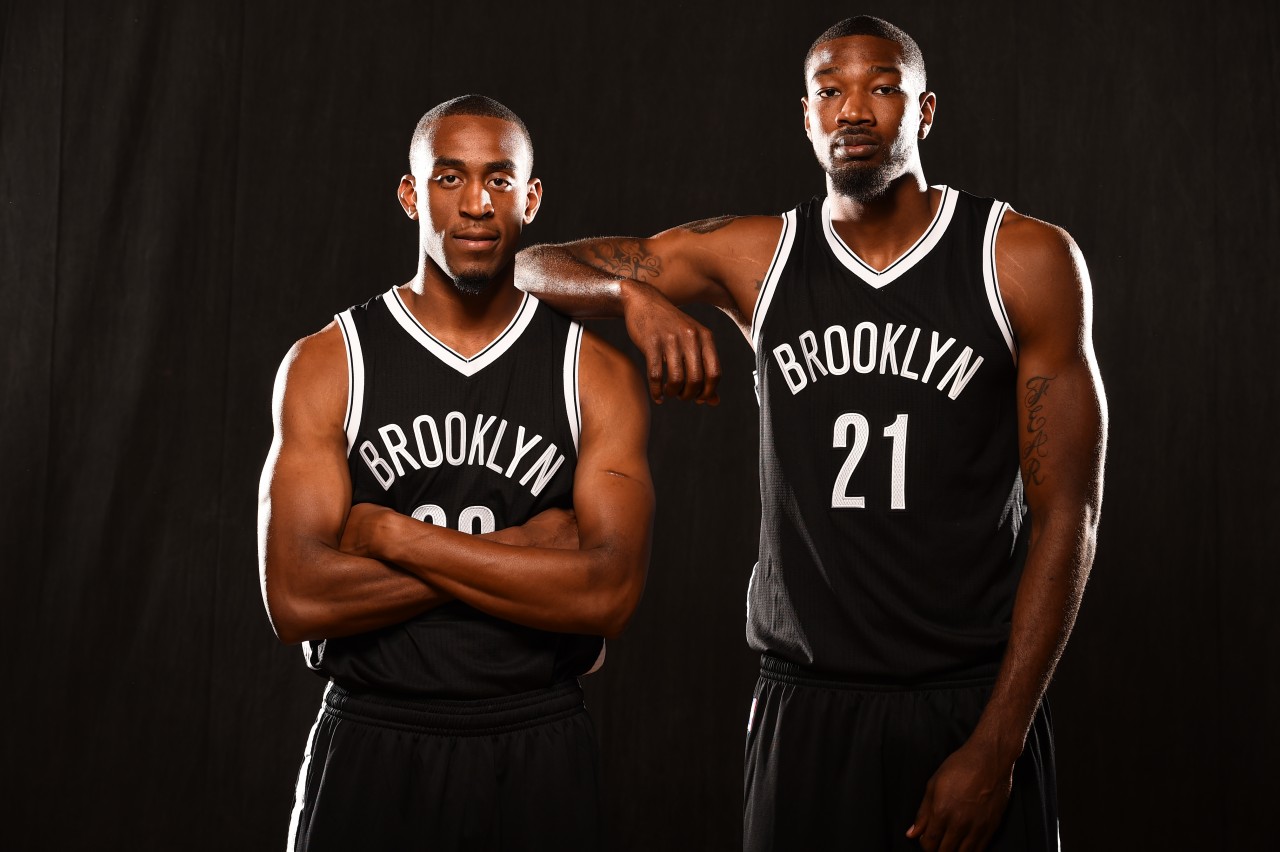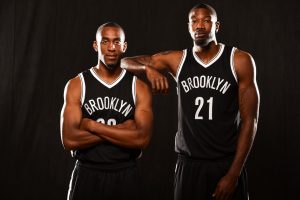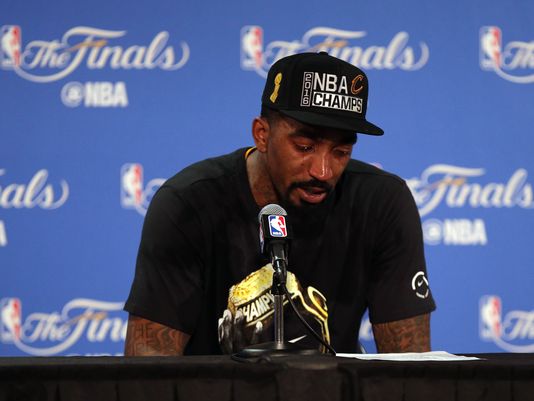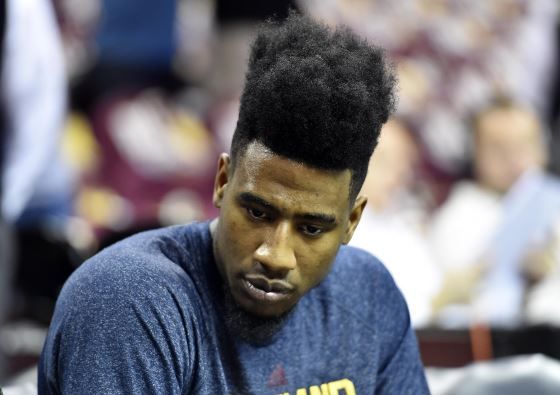
Cavaliers Bring Jefferson and Brown to Training Camp
2016-09-11As summer winds down and fall approaches, the Cleveland Cavaliers will bring in several players on training camp deals. As these signings happen, Cavs: The Blog will take some time to profile each player and what they could bring to the team. Today’s profile focuses on a pair of former Brooklyn Nets, guard Markel Brown and forward Cory Jefferson.
With the heat that has enveloped Northeast Ohio, the return of NBA basketball can seem like it’s a million years away. Yet here we are, two weeks from the start of training camp for your NBA Champion Cleveland Cavaliers. While fans await the conclusions of sagas involving J.R. Smith, Mo Williams, and the coaching staff, the Cavaliers have looked to fill out their roster by agreeing to training camp deals with players who will be given the chance to compete for the one or two roster spots the team has available. The latest players added to the mix are forward Cory Jefferson, and guard Markel Brown, both entering their third NBA season. While both have experience in the NBA, the real questions are what do these players bring to the table, and can they help the Cavaliers?
International hoops scribe David Pick first reported the signing of Jefferson on August 31. A four-year player at Baylor, Jefferson was selected by the San Antonio Spurs with the 60th and final pick of the 2014 NBA Draft, and subsequently traded to the Brooklyn Nets. While not considered a high upside prospect, Jefferson came into the league with good size and athleticism for power forward and a reputation for having a bit of a mid-range game. Some draft analysts thought he could be a rotation player for a Nets team that had just made the second round of the playoffs, while others thought he would be lucky to make the roster at all.
To his credit, Jefferson not only made the roster, he averaged 10.6 minutes per game over 50 games with the Nets as a rookie. Jefferson’s averages of 12.4 points, 9.8 rebounds, and 1.4 blocks per 36 minutes were impressive, but even more notably the Nets were a better team when he was on the court. Unfortunately, Jefferson didn’t exhibit the highest basketball I.Q. at times, and became known among Nets fans for some ill-advised plays as much as the potential he displayed. He was never able to become anything more than the team’s fourth big man, and didn’t get off the bench during their first round loss to the Atlanta Hawks in 2015. By the summer of 2015, the Nets had signed several other power forwards, and it came as little surprise when they waived him that July instead of paying him any guaranteed money.
The Phoenix Suns were Jefferson’s next destination as he signed a training camp deal with them in the fall of 2015. Once again, Jefferson was able to make the final cut, this time beating out former Cavalier Henry Sims for a spot with the Suns. As was with the case for the Nets the year before, the Suns were a better team with Jefferson on the court. Despite this, Jefferson wasn’t able to stick through the season. He was waived on January 7th after playing just six games with the team. The Suns did bring Jefferson back later on a 10-day contract on which he played two more games for the team, but he was not retained afterwards. Jefferson finished the season with the Bakersfield Jam of the NBA Developmental League, where he averaged 17.3 points, 9.8 rebounds, and one block in 19 games. His perimeter game and outside shot haven’t developed the way some experts thought they would, and other big men can push around defensively, but Jefferson’s ability to rebound and block shots as a help defender in a way that makes a positive impact for his team makes him an intriguing addition for training camp. In the right situation, he could develop into a rotation piece for a contender. Either way, Jefferson could very well be an upgrade over Sasha Kaun if the Cavaliers decide to keep a fifth big man.
Shams Charania of the Vertical first reported the Cavs agreeing to a deal with Markel Brown on September 6. Like Jefferson, Brown was acquired by the Nets after a trade in the 2014 NBA Draft. Selected 44th by the Timberwolves, Brown was best known as the backcourt mate of Marcus Smart at Oklahoma State. Playing four seasons for the Cowboys, Brown was primarily a shooting guard, but at 6’3″ he projected as a combo guard at the NBA level. Some teams thought Brown could play some point guard at the next level, and he impressed with his athleticism and defensive ability. That defensive ability allowed Brown to make an impact on a Nets team that took the 60-win Atlanta Hawks to six games in the first round of the 2015 playoffs. After playing sparingly through the first three months of the season, Brown made his first career start on February 23, recording 10 points and 11 assists in an overtime loss to the Denver Nuggets. Former Nets coach Lionel Hollins eventually inserted Brown into the starting lineup due to him being the team’s best perimeter defender, and Brown wound up playing 40 games with 29 starts his rookie year before losing his starting spot during the playoffs. In fact, despite being the youngest of the Cavaliers’ training camp invites at 24 years old, Brown has the most NBA experience, playing 16.2 minutes per game in 109 regular season games over the past two seasons.
So why did the Nets let Brown go? Well, there’s the issue of Brown’s offense, or lack thereof. Brown is a career 29.7% shooter from three, who has also made just 55.9% of his shots within three feet according to Basketball-Reference.com. In fact, at the basket was the only area of the floor where Brown has shot above 40% in either of the past two seasons. Needless to say, Brown has struggled when playing half court offense so far in his career and is more effective in transition, where he can make better use of his athleticism. Brown’s defense also took a step back in his second season, and his Defense Real Plus-Minus score of -3.64 ranked 90th among 93 shooting guards last season.
In spite of these issues, the jury is still out on Brown as an NBA player. To his credit, Brown improved his shooting form nearly all areas of the court from his first to second season, increasing his two and three point percentages by four and five percent, respectively. While it will difficult to make that kind of a jump again, it’s reasonable to think Brown could become a passable offensive player. He’s a solid shooter from the line, which gives some hope that his mid-range and outside shots can continue to improve. He has a respectable career assist-to turnover ratio of 1.7:1 and his a solid rebounder and shot blocker for a wing, let alone a guard. Like many players, Brown has also played better when given a consistent role. If he can rediscover the ability to defend the perimeter that he showed as a rookie, Brown could potentially serve as a defensive alternative at point guard to go along with Kyrie Irving and Kay Felder.
Along with the previously discussed DeAndre Liggins, the Cavaliers seem to be focusing on bringing players with a defensive mindset and some prior NBA experience to camp. Depending on when J.R. Smith re-signs and whether or not Mo Williams retires, it wouldn’t be a huge surprise if Brown and Jefferson are reunited as teammates, this time with the Cleveland Cavaliers.




IN THAT VOTING OF WHO MIGHT SURVIVE THE CUT / MAKE THE TEAM FROM THE ” INVITEES ” ADD ERIC MORELAND TO THAT LIST AND CAST A VOTE FROM ME THAT HE MIGHT MAKE THE TEAM
On September 13, 2016, the Cleveland Cavaliers are still NBA Champions.
Yep. Best Offseason Ever. Champs. Got Better.
Very much so anticipating the moments 15-13. Do you guys have a predetermined schedule for when the moments articles get released?
Hey Mallory, if you still read this, go buy the new Angel Olsen record. It’s amazing.
Agree with Cols! I saw Angel at the Nelsonville Music Festival last spring. Totally awesome. I have no idea how they got those publicity shots of her smiling; she has a tough persona, kind of like Jennifer Lawrence in “Winter’s bone”.
The WOW! moment at this year’s NMF was Yonatan Gat, which might be classified as an insanely high energy Israeli punk jazz trio. They left the stage and played on a table in the rain. I saw them again last week, but it was a little saner. They appeared to have been toasted and beyond at NMF.
Nice! How was Ms. Olsen in concert?
Besides putting on a great show, she is cool as a cucumber. Between songs, some loud guy yelled “Angel Olsen; don’t marry (someone), marry me” and she replied “I ain’t marrying anyone!” and started the next song. Probably all the guys and half the girls were in love with her.
Nice stuff, Mike. I still think Liggins has highest upside. Like Brown, but really bad offensive point guards rarely get better. Maybe Brown can lock himself in the gym Boobie style.
Also, his low RPM last year shows how much coaching effects RPM by putting players in the best (or worst) situations to succeed.
We are now up to 42 real live actual people with supposedly functioning brains who think Delly will have more assists than LBJ.
I blame chinese botnets.
Ha. I hope so, because LBJ was 8th in the league in assists per game last year.
Just eighth? Delly will be top five.
Top 2.
Do you mean, Matthew Dellavedova, NBA Champion?
We are still stuck on 1 real live actual person with a supposedly function brain who misunderstands the math of probabilities.
Meh; Im still in camp Felder :)
I like Felder a lot, but I wouldn’t mind seeing Brown play the defensive counterpart. We’ve got the spot on the roster and very, VERY limited options to add any more depth in the back court, couldn’t hurt trying him out. When we need backup PG help in the form of offense, play Felder. When we need backup PG help in the form of defense, play Brown. Brown shouldn’t have a hard time adjusting to the Cavs as he is best in transition and the Cavs are one of the best teams in transition.
Brown is not going to be in the normal rotation if he even makes the team.